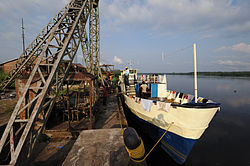History
As the river is not navigable from here downstream to Kisangani, a portage railway was built to link the settlement to Kisangani. It was built and operated during the colonial era by the Compagnie du chemin de fer du Congo supérieur aux Grands Lacs africains of CFL (1902-1960) whose rail and river steamer service connected Kisangani with Katanga. Upstream from Ubundu the river is navigable as far as Kasongo.
In 1951, Katharine Hepburn, Humphrey Bogart and the crew of the film The African Queen arrived in Ubundu by train for filming in the jungle. In those days, the town was described as a "pretty colonial outpost". [1]
The area saw some of the worst fighting during the Second Congo War. By around 2003, the town had no electricity, has very few facilities, and was considered a "very dangerous" place. [2]
In July of 2025, the DRC signed a $257 million concession contract to revamp the 115 kilometre long Kisangani–Ubundu railway segment, expected for completion in 2028. [3]
This page is based on this
Wikipedia article Text is available under the
CC BY-SA 4.0 license; additional terms may apply.
Images, videos and audio are available under their respective licenses.

